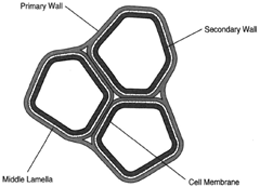Cell Walls
The presence of a wall secreted by the cell is a characteristic of plant cells. Animal cells do not produce walls. Many, but not all, Protista have cell walls. Fungi and bacteria produce cell walls. The distinction between the cell membrane and cell wall is an important one. The cell membrane is a part of the cell and is a living structure. The cell wall is not part of the cell; rather, it is secreted by the cell, lies outside of it, and is not living. The cell wall may appear homogeneous when viewed through an ordinary light microscope, yet |
| Figure 2-9 The primary cell wall, which is the first formed, lies against the middle lamella. The middle lamella is the point of contact between the two cells. The secondary cell wall lies inward, adjacent to the cell membrane, and is thicker than the primary cell wall. |
Soon after the completion of cell division, the primary cell wall is deposited by the daughter cells on each side of the middle lamella. As a result, the cell membrane rests against the primary cell wall rather than against the middle lamella. Because the secondary cell wall is secreted after the primary cell wall is formed, the secondary cell wall lies internal to the primary cell wall. Many perforations occur in the walls. Strands of cytoplasm commonly run through these perforations, producing linkages with the cytoplasm of adjacent cells. These strands are called the plasmodesmata.
The arrangement of cellulose fibers in the primary and secondary cell walls differs, being randomly oriented in the primary wall and spirally arranged in the secondary wall. Whereas the primary wall is flexible and can be stretched while the cell is growing, the secondary wall is more rigid. In many plants, the protoplast dies after secondary wall formation is complete. The constituents of the protoplast are then removed, leaving only the cell wall. This occurs in most wood cells.




